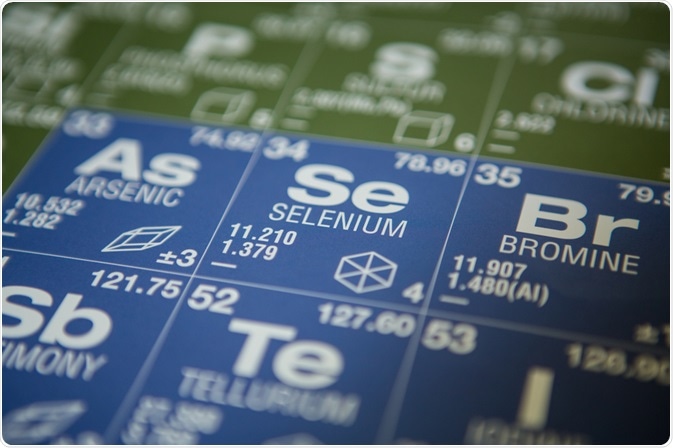Selenium is vital in maintaining anti-oxidant functions in the body. It is a trace element and is most often found in the form of the amino acid selenocysteine, which is a cysteine analog that has a selenium atom inserted in the place of sulfur in the cysteine molecule. This amino acid is coded for by the UGA codon when it occurs after a specific DNA sequence. UGA is a termination codon in most other situations.

Image Credit: Intothelight Photography / Shutterstock.com
Selenium compounds have been long sought after because of the various roles of this element in the body. There are at least 30 selenoproteins present in animals, 25 of which are present in mammals. Selenomethionine is the predominant form of selenium in most of them.
Antioxidant role
Selenium is present in several enzymes that prevent oxidative stress, such as dehydrogenases, glutathione peroxidases, superoxide dismutase, glycine reductase, thioredoxin reductase, and hydrogenase. These enzymes reduce highly reactive free radicals to alcohol compounds or water by coupling this reduction with the oxidation of glutathione.
When the body is deficient in selenium, these enzymes fail to function properly, thereby subjecting the body to oxidant damage. The eventual outcome of chronic oxidative stress includes damage to cellular lipids, proteins, and DNA, which eventually leads to the development of various cancerous changes, chronic inflammatory conditions, and cardiovascular/atherosclerotic disease.
Selenium also helps to regenerate the other important antioxidants in the body, such as vitamin C (ascorbic acid), and vitamin E (α-tocopherol). Taken together, this element maintains a high level of redox activity in the body systems.
Glutathione peroxidase is the name of a family of similar enzymes which contain selenium at the active site and act as antioxidants. These selenoenzymes, which catalyze the reduction of hydrogen peroxide to water, are made up of four protein subunits, each with one selenium atom. Glutathione peroxidase is found in the cytosol, gastrointestinal tract, plasma, and in the reaction involving phospholipid hydroperoxide.
Thyroid hormones and selenium
Another important role of selenium is in the iodothyronine-deiodinase complex of enzymes that are required for the effective production of active thyroid hormones.
Selenium deficiency and disease
Selenium deficiency is thought to precipitate serious health effects in humans, such as a form of cardiomyopathy called Keshan disease, which is predominantly found in certain parts of China. In such areas, a form of osteoarthritis called Kashin-Beck disease is also endemic, causing major disabilities. The deficiency of selenium in geographical areas where both of these conditions are rife has led to the hypothesis that physiological stress responses are inefficient when antioxidant levels are low.
The commonly recommended dietary allowance of selenium is 55 micrograms (µg) per day at all ages.
Synthetic organoselenium compounds have been researched to mimic its antioxidant properties, making use of the advantages that selenium has over the similar element sulfur. One of the most important among these compounds is ebselen, or 2-phenyl-1,2-benzisoselenazol-3(2H)-one.
Antitumor organoselenium compounds
Selenium supplements of 200 µg a day have been reported to have anti-tumor activity. Inorganic selenium compounds with such properties act by generating free radical species which damage or kill cancer cells.
Selenium supplementation has been extensively studied to find an association with site-specific cancers, as well as cancer-related mortality. However, while many large observational trials pointed to an association between higher selenium levels and significant reductions in prostate and colon cancers, this was not confirmed by interventional trials.
At present, selenium supplementation is known to be related with a 25% increase in the incidence of squamous cell skin cancer, with doubtful effects on the incidence of other cancers.
The first synthetic organoselenium compound to be studied was P-methoxybenzeneselenol, from food. However, today, P-phenylenebis (methylene) selenocyanate and other similar compounds have been researched as chemopreventive agents, which show less toxicity than natural selenoamino acids or selenite.
Ebselen has also shown carcinostatic activity in human breast cancer and liver cell lines. Other compounds in this category include triphenylselenonium chloride.
Antiviral organoselenium compounds
Most synthetic organoselenium compounds show activity against viruses, including some types of herpes simplex, parainfluenza, rhinovirus, and Semliki Forest viruses. Selenazofurin, 7-methyl-8-selenoguanosine, selenium-substituted purine analogs, acyclouridine compounds, and 3’-Se-dideoxynucleoside analogs are good examples of active antiviral organoselenium agents.
3’-Se-dideoxynucleoside analogs act powerfully against both hepatitis B virus (HBV) and human immunodeficiency virus (HIV). These agents were therefore developed to replace 2’,3’-dideoxynucleoside analogs, which have been effectively used as part of a protocol that includes protease inhibitors. This course of treatment has been shown to significantly reduce mortality rates, especially those which are secondary to infections, in HIV patients.
Selenium supplementation, in combination with multivitamins, has shown a powerful effect in delaying the overall progress of HIV infection in a recent trial which compared selenium alone, multivitamins alone, selenium with multivitamins, and placebo, in their effects on disease activity.
Antibacterial organoselenium agents
Ebselen has been found to be active against Staphylococcus aureus. Other selenium-substituted compounds inhibit the growth of fungi, including Candida albicans and Saccharomyces cerevisiae.
Anti-inflammatory organoselenium compounds
Oxidative damage to body tissues is well-known to be mediated, in part, by reactive oxygen and nitrogen species (ROS and RNS, respectively). The damage these agents cause is a potent inducer of inflammation. Glutathione peroxidase levels have also been shown to be low in conditions known to be caused by oxidative stress. However, present research has not shown a benefit of selenium supplementation reudcing the incidence of heart disease or hyperlipidemia.
In addition to being a powerful anti-inflammatory agent, ebselen is also associated with preventing oxidative damage. To this end, ebselen has been found to inhibit the production of ROS, the nitric oxide synthase by endothelial cells, and leucocyte adhesion to endothelium with migration through the endothelial barrier.
These properties of ebselen have led to its use in preventing and treating atherosclerotic heart disease. Moreover, ebselen has also been shown to inhibit inflammation of the lungs. Other promising compounds include the diselenides bis-(2-hydroxyphenyl) diselenide, bis (3-hydroxyphenyl) diselenide, and bis (4-hydroxyphenyl) diselenide.
References
Further Reading
Last Updated: Apr 26, 2021